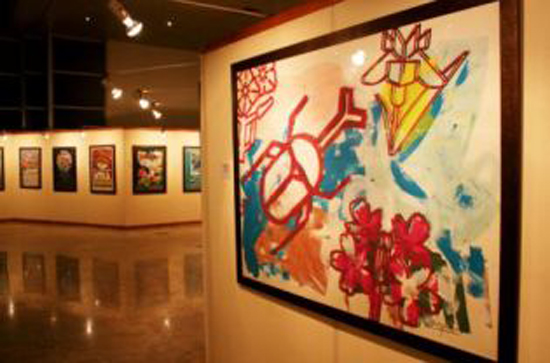
Italy, with its rich artistic heritage, may be a long distance from Jakarta, but a slice of the country’s contemporary art can now be explored without having to fly overseas.
At the entry hall of Museum Nasional, Italian painter Ugo Nespolo’s first exhibition in Indonesia, titled "Beau Geste", fills the space with a jubilant beauty. Nearly 50 of Nespolo’s works are on display for this exhibition, which was organized by the Italian Embassy and the Italian Institute of Culture Jakarta.
Using bright colors and bold strokes, Nespolo’s lively paintings, sketches and posters convey some of the thinking behind the famous artist, sculptor, designer and movie director.
“My inspiration comes from real life because I always thought the real strength of art is to be close to the real world,” the 70-year-old said.
“I don’t like the idea of an artist working for himself in a dark corner. I prefer when an artist takes care, and puts in a representation of the real world. The color is the media.”
Nespolo referred to the avant-garde — such as Futurism and Dadaism of the early 20th century — as movements born from the idea of taking the artist out of the studio and “into the middle of real life.”
Having lived in New York in the 1980s and met Andy Warhol many times, Nespolo said the Pop Art movement was the embodiment of this idea.
'Supreme mission'
“The role of an artist, for me, is a man who thinks about his task.” But while rejecting the idea of an artist who comes out of his studio on “this supreme mission as a priest", Nespolo’s definition of an artist’s role is simple.
“I think an artist needs to be cultivated and connected to his brain. He needs to be a real man — with his phone in his pocket and his car outside,” he said with a smile.
Having graduated from the Turin Accademia Albertina di Belle Arti and the University of Turin, Nespolo’s career in the Italian artistic panorama dates back to the 1960s.
He explored Pop Art and Arte Povera — a minimalist movement that made use of worthless materials — and in the 1970s, endeavored to create a new means of expression — experimental cinema.
Today, Nespolo works on paper and wood, and with sculptures and glass, drawing his motivation from “almost everything.”
Asked about the deeper meaning of his work, Nespolo said the ideas behind today’s artistic era, post-modernism, needed reflection and reassessment.
“Now is the moment to rethink what we do and why we do it, and that’s another idea connected to the show,” he said in reference to the exhibition’s theme, an exploration of the idea of beauty. “Beauty is a word we try to say again because with the avant-garde, you couldn’t say beauty. What is beauty? Why beauty?”
Believing art’s post-modernism chapter is closed, Nespolo said it’s time to “maybe write again manifestos.” However, he said he found it challenging to make any predictions about the direction in which art is moving.
“I think at the moment we are at the philosophy of thinking about a new idea, called new realism. However, realism doesn’t mean to make reality again. It means less interpretation and more reality.”
Beau Geste
A solo exhibition by Ugo Nespolo
Until June 5
Museum Nasional
Jl. Medan Merdeka Barat No. 12,
Central Jakarta
Tel. 021 386 8172
JAKARTA GLOBE INTERNSHIP
Krissy Dwyer is on internship at the Jakarta Globe. This is her first feature for the newspaper. She graduated from AUT University in 2011 with a Postgraduate Diploma in Communication Studies in journalism.



